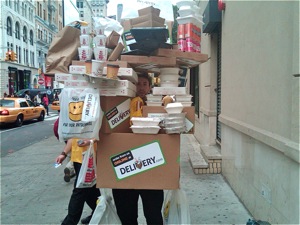The following is a Q&A with yours truly on the current state of affairs in guerrilla marketing.
Q: How has guerrilla marketing evolved?
Guerrilla thinking has evolved tremendously in the last 24 months. Press seeking guerrillas have shifted away from street theater to something with online legs. Part of this is fishing where the fish are. Part of this is that if you can gain Likes or YouTube channel subscriptions, your initial contact can turn into a more lasting relationship. Part of this is the press itself—the press is more likely to wax on about a social program than a purely street program at this moment in time.
Q: What’s up with street stunts?
Frankly, I’ve never been a fan or promoter of the street stunt approach. They are typically a brief encounter with little residual value. The challenge with guerrilla has always been to provide a reasonable exchange of value between brand and consumer. In exchange for a consumer’s time, the brand must provide some value, either genuine utility or at least a good laugh. The reason the HSBC BankCab is still on the road after seven years is that the value exchange is extraordinary. First, people love to see an old Checker driving around the streets. Second, when they get in the BankCab, it is a refreshing experience complete with a truly knowledgeable cabbie. Third, HSBC customers get a free ride when engenders brand love. We recently renovated the HSBC BankCab, enabling it to run on compressed natural gas, thus making it a more “green” experience. As street programs go, this is about as good as it gets.
Q: What’s cool right now?
The most exciting area of guerrilla right now, is the social to offline movement. Skittles “Mob the Rainbow” program is one great example of this. Skittles solicits ideas from its 10 million strong Facebook fan base, which sometimes lead to hilarious offline executions. For example, fans suggested sending Valentines to a particular postal worker. Skittles did just that and produced a funny viral video which brought the program full circle. JetBlue is using its strong Twitter following in a similar fashion. Earlier this year, @JetBlue tweeted they were on a particular street corner in Manhattan giving away tickets. In a matter of minutes, 300 eager travelers showed up and of course, JetBlue got some nice ink for this as well. In this way, social media has replaced email as the ignition switch for flash mobs.
Q: How does social fit into a guerrillas plans?
Any marketer considering a physical guerrilla interaction would be crazy not to also bake in a social component. The social component should give the program legs, extending the offline interaction online. It also provides a home for videos and or photos taken of the physical interaction thus sharing these experiences with a larger audience. The social component also helps amortize the cost of the potentially expensive offline component. Finally, the social component provides an opportunity for feedback something that is not always easy to get in the physical arena.
Q: Is the physical street experience dead?
Since marketing success has often been about zigging when others zag, a few enlightened marketers will renew their emphasis on the physical experience and the true engagement opportunity it represents. Touching someone deeply often requires a physical touch. Online dating sites do the matchmaking but typically the fire doesn’t flame until the couple actually meets.
Q: What roles are left for guerrilla marketing?
Guerrilla thinking has never been dependent on one particular type of interaction. It has always been about making more out of less, breaking the ice in order to build meaningful and hopefully lasting relationships. Social marketing has proven its ability to maintain and nurture relationships but the jury is still out on its ability to generate trial from new customers.
Q: How has Renegade evolved from a guerrilla standpoint?
I see social marketing as an evolution of our long-time guerrilla practice. The goals haven’t changed but the tactics we use continue to grow and evolve. Five years ago, three out of four incoming calls would be from clients seeking guerrilla ideas. Now those same clients are requesting social marketing ideas. The impetuous for the calls is the same—help us engage customers cost-effectively.
